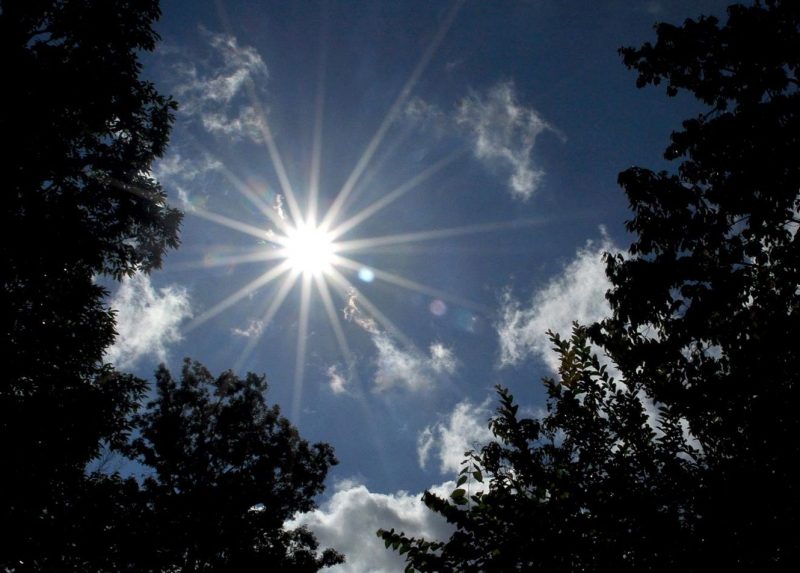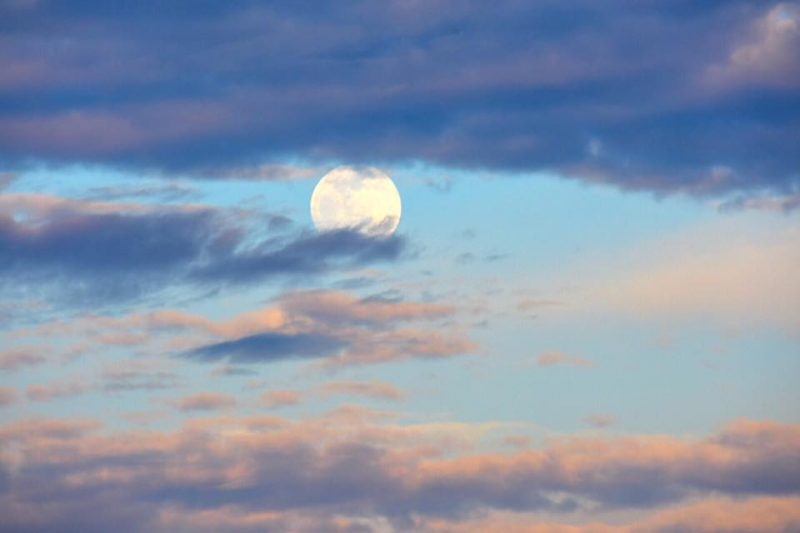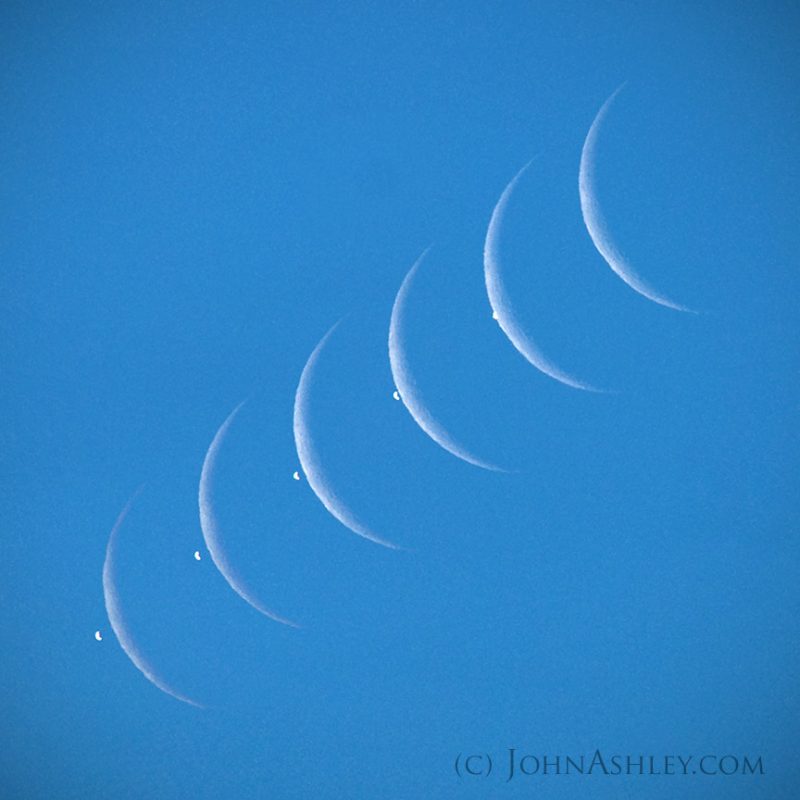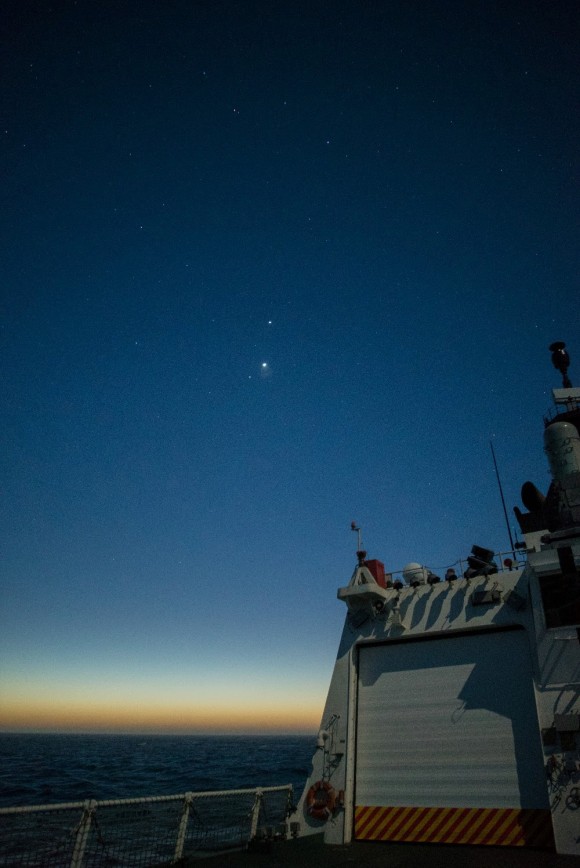Top 10 space objects to see during the day

What are the top 10 space objects to see during the day? Some are easy, others are more challenging. Here is our list of the top 10 space objects to look for in the daytime sky.
Seeing space objects during the day
If you think nature-watching in the daytime sky is limited to clouds and birds, you are missing out. There are several space objects visible in the daytime but catching them has its limitations and difficulties. And, as with all skywatching, it also has its rewards. So here is a list of 10 space objects to see in the daytime sky. Aside from the first three, some daylight observations are relatively difficult, but possible if you’re prepared. On the other hand, the last few objects are impossible to plan for or predict.
That said, here they are, in increasing order of difficulty: your top 10 space objects to see during the day.

1. The sun
Obviously, you see the sun during the day. But paradoxically, we should never look at it, because direct observation damages our eyes. So never look right at the sun. Gazing at the sun directly can damage your eyes.
If you take precautions – and rig up a simple indirect viewing method for sun-watching – what do you look for? Most people look for sunspots, which can be quite large. You can also use a telescope equipped with a safe solar filter. It’s easy and fun to count the number of sunspots you see from day to day. Counting sunspots doesn’t take long, and, if you record what you see, you notice profound changes over time.
The sun has an 11-year cycle, during which the dark sunspots on the sun’s surface wax and wane. We’re in the beginning phase of a solar cycle now, with frequent and some impressive sunspots. And, in the coming years, the number of spots on the sun should continue increasing until the solar cycle peaks.
Some sun resources
Read more: EarthSky’s Today’s Sun Activity Article
Also, we recommend this website Spaceweather.com, they track sunspots, solar activity and offer mobile phone alerts.
Read more: Do-it-yourself sunspot watching from SpaceWeather.com
Additionally, the sun gives us a whole range of atmospheric effects. Search here at EarthSky for words like “halo around the sun,” “rainbows,” “iridescent clouds” and “the glory.” Or browse Les Cowley’s great website Atmospheric Optics.
2. The moon during the day
Possibly 75% of the public is unaware the moon is visible in the daytime sky. That’s not hard to understand, since many people nowadays spend most of their time indoors. Hence, they don’t pay much attention to the sky.
In addition, the moon is not in the daytime sky every day. Like the sun, it is below the horizon half the time. Plus, even when the moon is visible during the day, it’s often a thin crescent and not easy to see. So some people are surprised to notice the moon in the daytime sky. But voila. If you look up frequently, you’ll see it often.
Read more: 4 keys to understanding moon phases (and daylight moons)

3. The planet Venus
Under the right conditions, the planet Venus is visible when the sun is also in the sky.
The image above shows Venus as a crescent, like a tiny crescent moon. But Venus only appears as a crescent at certain times in its orbit, and you need some optical aid to see it.
Anyone who sees Venus in a reasonably dark sky knows it is usually dazzlingly brilliant. Observations in the daytime sky are more difficult simply because the surrounding sky is so bright during the day. The contrast between a planet and the sky is much lower during the day, making the planet harder to see. Venus appears as a tiny white dot that often seems to “pop” out at you in a daylight sky. It helps to know where to look, especially locating it near the moon or following it from dark through twilight.
In June 2022, Venus can be found easily in the sunrise direction in the morning sky. It’s exceedingly bright, but will sink lower each day until disappearing from the morning sky in October. Venus reappears in the evening sky in December 2022.
Some Venus resources:

4. Earth-orbiting satellites during the day
Many people are surprised satellites are easy to see, but they are quite common in dark, nighttime skies. Seasoned observers see them frequently as nighttime falls. They look like steadily moving “stars” – silent – and very high up. So, at night, it’s very easy to see satellites. But how about during the day?
You can see the International Space Station (ISS) during the day. The ISS is sometimes the third-brightest object visible in the sky, after the sun and moon. Why only sometimes? The position and brightness of ISS in your sky is variable, depending on where the space station is with respect to you. Also, the brightness of Venus – which is usually the sky’s third-brighest object – varies. Sometimes ISS is brighter than Venus, and sometimes Venus is brighter than ISS.
Still, ISS is a very bright satellite. If conditions are optimum, you might see it in daylight. Spotting a visible pass of ISS in the daytime sky is a fun pastime. Eventually, you’ll be an expert at daylight ISS sightings and you’ll know when they occur over your location. Here’s an article to help you get started.

5. The planet Jupiter
Even some seasoned astronomers are surprised to hear mighty Jupiter is visible with the unaided eye in a sunlit sky. A word of caution here, this isn’t an easy observation. Jupiter is significantly dimmer than Venus, and finding it takes a bit more effort. Not to mention, it helps to have exceptionally good eyesight and excellent atmospheric conditions.
The best time to see Jupiter in daylight is when it’s near a “quadrature.” In other words, when Jupiter is about 90 degrees away from the sun in the sky. Plus, the sky is slightly darker there, due to a phenomenon known as polarization. This is similar to the arrangement of first quarter and last quarter moons. In fact, it is very helpful to have a quarter moon nearby, using it as a sky landmark guiding you to Jupiter. For example, notice the quarter moon in the image above.
When is Jupiter at quadrature next? Pretty soon, it happens on June 29, 2022.

6. The planet Mars
Although only a few observers catch Jupiter in the daytime with the unaided eye, even fewer score a glimpse of Mars. However, it is possible. Mars reaches -1.9 magnitude at opposition on December 8, 2022. The best time to see Mars during the day is around a very close opposition when Mars shines brightly at -2.9 magnitude.

7. Stars during eclipses
This is cheating, but stars and the brighter planets are visible in the daytime sky with the unaided eye. However, this is normally only during a total solar eclipse. Such observations are of historical significance. And in fact played a crucial role in one of the first confirmations of Einstein’s theories of relativity.
A few observers report seeing some bright stars, such as Sirius, with the unaided eye in the daytime sky. These sightings require exceptional eyesight and exceptional sky conditions.

8. Comets during the day
Like the meteors with which comets are sometimes confused, many bright comets have been observed in the daytime sky. In fact, although not necessarily always easy to observe, they are not all that rare. Comet McNaught was visible in daylight…
Read More: Top 10 space objects to see during the day

